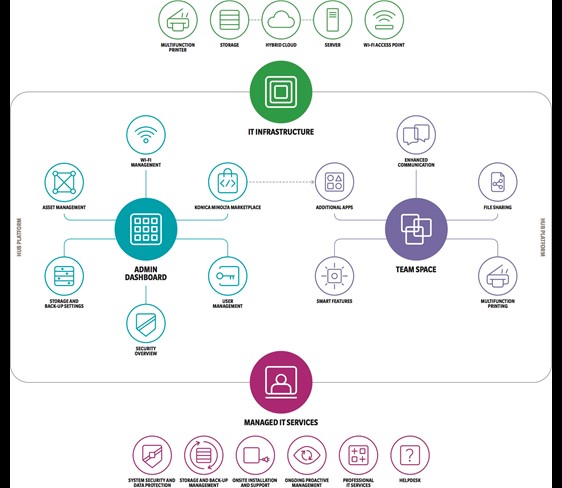
HITTING A MOVING TARGET
Developing a brand in tandem with the products themselves made for an unusual communications journey for Konica Minolta. Brittany Golob asks how the process made for a more robust brand and a clearer communication of the company’s new brand extension
When the project began, even the team working on it didn’t really know what it was. When brand agency Frank, Bright & Abel was appointed to work on it, the team working on it didn’t really know what it was. When it was being developed, even the leaders overseeing it didn’t really know what it was.
The newly launched Workplace Hub brand is the culmination of a now-three year push toward innovation within Konica Minolta. It also represents an approach to communications that allowed both the production and communications teams to develop their strategies as the project was in progress.
For Konica Minolta, this way of working has allowed the three year-old Business Innovation Centres (BIC) around the world to benefit from agile thinking and creativity. Rather than testing ideas and reevaluating strategies in order to reach the team’s objectives, director of marketing communications at Konica Minolta, Stacey Sujeebun, says the teams are constantly pushing their ideas forward to develop new solutions to business problems. “We never have a fixed, concrete idea at the outset,” Sujeebun says. “Instead we have developed an innovation programme that is based on design thinking enabling us to incorporate continuous customer feedback at every key milestone and new technology trends that are emerging. We have to be flexible and we have to be able to incorporate all those new ideas as the programme evolves to overcome our customers’ pain points.”
The kernel of what Workplace Hub would become came from London’s Business Innovation Centre head Dennis Curry, now deputy CTO, at Konica Minolta. Curry was talking to CEO Shoei Yamani about a product that could make better use of the space taken up by one of Konica’s key assets – the office printer.
Printers and imaging technology have been Konica Minolta’s bread and butter since Konica and Minolta merged in 2003. With a global portfolio in all manner of imaging tech and business solutions – from x-rays to office printing to laboratory spectroscopy – Konica Minolta was firmly not an IT services company. But Curry’s team had an idea that would change all that.
The BIC, under Curry’s direction, examined the frustrations and challenges around IT management. Existing tools, like Skype, can be simple and effective, but when collaboration suffers because of the limitations of technology, businesses are losing efficiency. “When [IT systems] work well, you don’t think about it. But when they don’t work, they frustrate you. We’re trying to take out some of that frustration and build from there,” Sujeebun says.
Konica Minolta commissioned Frank, Bright & Abel to begin work on the communications strategy and brand for what was then a single product. When the brand team came on board, co-founder Rebecca Price says she had to determine if the team was developing a launch campaign, a new brand or a sub-brand of Konica Minolta. Frank, Bright & Abel worked with Sujeebun to outline a communications strategy, determining that Workplace Hub was indeed to be a brand extension, with multiple products beneath its umbrella.
What exactly Workplace Hub was, however, was still in flux. Curry’s team was busy in development and Price’s team busy devising strategy. While the former was exploring the technological frontiers of business technology, the latter was putting pen to paper and crafting a brand narrative. Working simultaneously, development of both product and brand proceeded into new directions. Frank, Bright & Abel’s creative director Janet Edwards says the project was like working toward a “moving target.” For Workplace Hub, the BIC found that more was needed than a simple IT system. For the brand, Frank, Bright & Abel found that different audiences around the world perceived IT in a different way.

Workplace Hub developed into a tool enabling businesses to cope with changes to the workplace. Price, Edwards and strategy director Nick Thomson developed the narrative with the help of research. The first set of which put three different brands to the test. Responses from Europe conflicted with those from the US which conflicted with those from the UK. None were loved, but none were expected to be. “Generally [the strategies] landed reasonably well, but I remember one particular focus group in New York where someone yelled out, ‘But what the goddamn hell is it?!’” Price says, “As the work developed, we made sure that not only did we write the core narrative that nailed it, but we developed subsequent blocks of copy that went into successive detail.”
Thomson adds, “We developed a personality for it. That informed the tone of voice and the look and feel.” Workplace Hub was almost becoming a reality. Edwards says Frank, Bright & Abel worked with Konica Minolta to determine what Workplace Hub could look like or feel like. “It wasn’t a tada moment because the whole thing was fluid and moving all the time,” she adds.
Challenges presented themselves along the way, though. Konica Minolta discovered it had to build its credibility as an IT services provider. Frank, Bright & Abel discovered that the IT market was not receptive to a radically creative brand or narrative. Research proved that not only was Konica Minolta not there yet, but the sector itself was not either. “For a platform that you might need to run the most important aspects of your business, it just didn’t have the right cues,” Price says of the most abstract approach devised by the agency.
“This is the B2B world, not B2C,” says Thomson. “We had to, in terms of the tone and the style, replicate Konica’s stage of evolution so it couldn’t be so far that it just seemed not credible for Konica Minolta. It’s a stepping stone to where they want to go in the future.” Meanwhile, Curry’s team was busy envisioning a future of businesses working in partnership to solve the world’s problems. This required a system to facilitate it. Workplace Hub is designed to be that system.
But even months into the project, translating that technological approach to a real-life, problem-solving brand proved challenging, even for Konica Minolta. Frank, Bright & Abel created a graphic icon that works as a lens, highlighting different elements of the brand. But it also, crucially, worked on a system of icons for Workplace Hub. The resulting icons were a combination of existing pictograms and bespoke icons designed to give form to Workplace Hub’s capabilities. Then Edwards, Thomson and Price organised this system into four interrelated diagrams connecting Workplace Hub’s systems and services in icon form.
That was the moment that changed everything.
Until then, Frank, Bright & Abel was working on the brand based on what the BIC could tell the agency about Workplace Hub. That amounted to a lot of technology and a good deal of ambitious thinking about the workplace of the future. But when the icon system was drawn up, not only did it clarify things for Frank, Bright & Abel, but it finally made Workplace Hub a reality for Konica Minolta itself. Edwards says, “They were really pleased because they were like, ‘That’s it!’ This is making it simple and easy.” Putting Workplace Hub into icon form “helped them explain it internally. That was a key moment,” Thomson says.
The diagram is crucial because it organises Workplace Hub’s functionalities into understandable areas. For the first time, Workplace Hub was more than a name. It was more than a collection of functionalities. It was more than a better use of the space taken up by the office printer.
‘Printers and imaging technology have been Konica Minolta’s bread and butter since 2003. From x-rays to office printing to laboratory spectroscopy. Then came an idea that would change all that”
Workplace Hub is defined by four areas. One, implemented in aqua, is the administration dashboard. The icons here represent the basic IT management capabilities any IT system should have. Second, the purple ‘Team Space’ offers the collaborative functionality that will set the tone for Konica Minolta’s vision of the future of work. Third, is managed IT services, in magenta, where bespoke icons allow users to put the new technology to work in increasing business efficiencies through IT. Finally, the infrastructure, in green, encompasses the capabilities that actually do make better use of the printer.
Ticking off the days until the March 2017 brand launch, the suite of products that now comprised Workplace Hub were taking physical shape. And the brand was being put through its final test stages where the strapline, ‘IT on your terms,’ was developed and the colour palette – a selection from Konica Minolta’s corporate colour palette – was implemented.Only seeking to maximise efficiency, Konica Minolta ultimately repositioned itself as a credible IT services provider. The tone of voice and thinking is fresh, says Edwards, but, “They’re still professional and they’re making you think about Konica in a different way.”
Sujeebun adds, “It’s a subtle shift in positioning and it’s also brand extension. We’ve always been within IT, but historically we’re known for our print or print production category. Now with our IT acquisitions and innovation initiatives, such as the Workplace Hub, our position in the IT sector is more prominent.”
When the project began, the team working on it didn’t know what it would become. When Frank, Bright & Abel wrote the first narrative, it didn’t know what the brand would become. When Konica Minolta first instituted its Business Innovation Centres, it didn’t know for sure what the outcome would be.
With Workplace Hub going to market in September, the team now knows that it is a family of products that facilitate better IT management and capabilities for businesses of all sizes. Frank, Bright & Abel have pushed the boundaries of creativity in IT communications. Konica Minolta now stands poised to enter the world of IT services.



